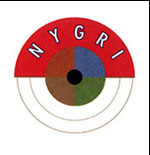



 |
 |
 |
 |
Click above to change
contrast or text size.
| The International Collaborative Exfoliation Syndrome Treatment Study - ICEST |
|
THE INTERNATIONAL COLLABORATIVE EXFOLIATION SYNDROME (XFS) TREATMENT STUDY (ICEST): study design, methods, and baseline data of enrolled patients. Robert Ritch, Vincent Hugo, Theodore Krupin, Anastasios GP Konstas, Jeffrey Liebmann, Elena Ilitchev, Michael Marmor, and the ICEST Study Group. The New York Eye and Ear Infirmary, New York, New York. University Eye Specialists, Chicago, IL, AHEPA Hospital, Thessaloniki, Greece, New York University School of Medicine Purpose: To determine the efficacy of treatment with latanoprost in combination with pilocarpine versus timolol or timolol/dorzolamide fixed combination (Timoptic or Cosopt) in eyes with XFS and elevated intraocular pressure (IOP). Methods: This is a randomized, open-label study to test the hypothesis that improving both pressure-dependent and pressure-independent aqueous outflow and minimizing iridolenticular friction will interfere with the progression of XFS, allow improvement in trabecular function, and be more effective over time than simply reducing aqueous formation. Randomization was performed across the centers, per patient rather than per eye to avoid any crossover effect caused by aqueous suppressants. Group I was treated with latanoprost and pilocarpine, both in the evening, and Group II with Timolol or Cosopt b.i.d. Only one eye per patient was randomized. Patients were followed for 2 years with assessment of IOP, visual field progression, tonographic outflow coefficient and trabecular pigmentation at the 6:00 and 12:00 position. Results: A total of 277 patients with XFS and elevated IOP with and without glaucoma were enrolled at 12 centers in 7 countries between October 3, 2000 and July 4, 2003. The mean age was 69 years; 146 (52.7%) of the subjects were men and 131 (47.3%) were women. Clinically unilateral XFS was present in 118 (42.6%) patients and bilateral XFS was present in 159 (57.4%). Trabecular meshwork pigmentation at the 6:00 angle in the treated eye, graded on a scale from 1 to 5, was significantly associated with IOP (p=0.01), but not with the outflow coefficient, sex, or age. Among the 277 patients, 150 (54.2%) were treated in the right eye and 127 (45.8%) in the left. Latanoprost and pilocarpine were assigned to 145 (52.3%) and Timolol or Cosopt to 132 (47.7%). Conclusion: The ICEST study should provide us with guidance on the best initial treatment for patients with XFS and elevated IOP. |
New York Glaucoma
Research Institute
310 East 14th St.
New York, NY 10003
(212) 477-7540